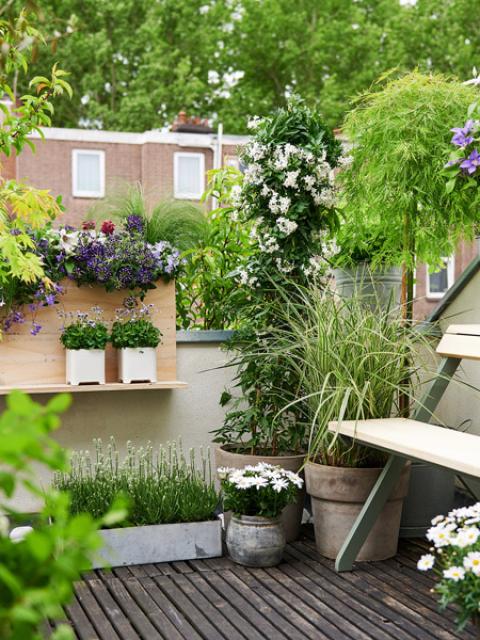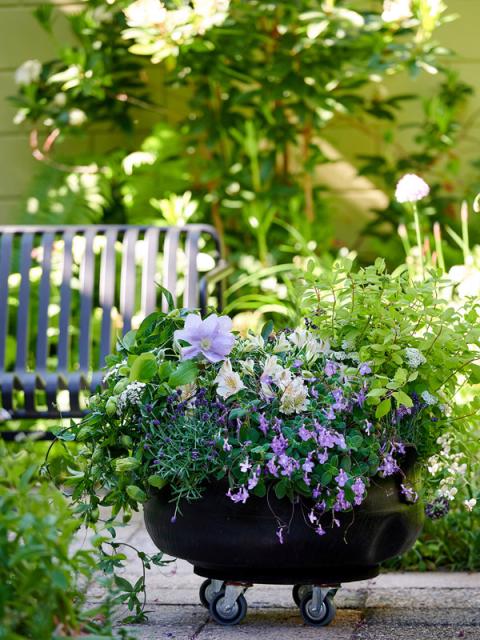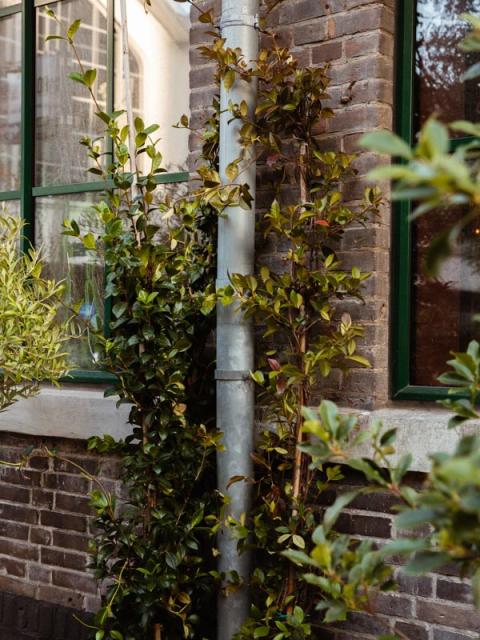Clematis: characteristics and flowering
Clematis, also known as woodland vine, is an evergreen climbing plant. The Latin name clematis is derived from the Greek ‘clématis’ meaning vine or climbing plant. Clematis is known for its striking flowers and variety of colours and shapes. The flowers are usually star-shaped or bell-shaped, depending on the species. It often has four petals around a yellow heart, but there are also double-flowered varieties in different colours with fringes in the middle. Flower colour ranges from white to pink, purple, deep red and blue. The beautiful flowers can be very small, but can also be larger than 20 centimetres across.
Clematis belongs to the ranunculaceae family (Ranunculaceae), which includes plants such as anemone, buttercup, columbine and delphinium. The flowering time of clematis varies from species to species. Some species flower in spring, others in summer or autumn. The flowering period varies from a few weeks to several months, depending on conditions.
Clematis tends to do well wherever its planted and doesn't need much care. The woody, leafy tendrils happily wind themselves around whatever they're close to and climb up arches, walls, pergolas or any other structures.

Clematis species
There are over 250 different species of clematis, which means there is a huge variety of colours and shapes. Distinctions are often made according to flowering time in regards to the different species. There are the early-flowering varieties (spring), medium-flowering varieties (late spring/late summer) and late-flowering varieties (late summer/early autumn). Clematis can also be categorised according to external characteristics. The following are common popular varieties:
- Clematis armandii (early-flowering): this evergreen species flowers between February-April and has small to medium-sized, star-shaped white flowers, often with a slight scent.
- Clematis alpina (early flowering): this species usually flowers between April-June and can be recognised by its small, bell-shaped flowers in blue, purple or white.
- Clematis montana (early flowering): this species usually blooms in May and has large, often double flowers in pink, white or red. The flowers have a strong scent.
- Clematis viticella (late-flowering): this species flowers between July and September. Clematis viticella blooms profusely with medium-sized flowers in purple, pink, red and white.
- Clematis jakcmanii (late-flowering): this species flowers between July and September and can be recognised by its large, deep purple flowers with contrasting, yellow stamens.

How to plant clematis: choosing a location and planting tips
Planning to plant clematis in your garden or on your balcony? Then check out these tips and step-by-step plans for garden plants, and look at our advice below regarding the best planting location for clematis.
- Clematis thrives best in a spot in sun or semi-shade. The greenery and flowers can be in full sun, but the roots likes cool temperatures. It can be a good idea, for example, to plant a shady shrub in front of your plant, or cover the base of the plant with stones or a layer of mulch.
- Clematis is a climbing plant. You should choose a spot where clematis can reach height with support (such as a framework, string, iron wire or fence) to wrap itself around.
- You should preferably plant clematis in a spot out of the wind and in well-drained calcareous soil.
- Plant clematis in autumn, when the soil is still warm and sufficiently moist. Spring planting is possible, but you will have to water the plant more often during its period of early growth.
How to care for clematis
You'll want your clematis to grow and thrive as much as it possibly can. Check out the tips below for caring for clematis:
- Clematis can be thirst, so never let the soil dry out during hot, dry periods. Make sure the soil is moist but not soggy, as this will cause root rot.
- Give clematis extra nutrition (such as organic fertiliser) during the growing period (usually in spring). During flowering you don't need to feed the plant.
- Clematis is hardy. This means that the plant can withstand frost and doesn't need to be covered or sheltered during the cold months.
- Not all clematis varieties are evergreen, but several early-flowering varieties, such as Clematis armandii, are.

When and how should you prune clematis?
Pruning clematis is important for healthy growth and beautiful flowers. Some species of clematis bloom only on the shoots formed the previous year (early-flowering species). Other species bloom only on shoots from the same year (late-flowering species). When and how to prune clematis depends on the group your clematis falls into. The flowering time of your clematis determines which group it belongs to.
- Group 1 (blooms in April and May): clematis species that flower in spring (often small-flowered varieties), bloom on stems formed the year before. These clematis may be lightly pruned immediately after flowering (in summer). Remove all dead and weak shoots and cut the branches back to just above a thick bud. If necessary, you can prune old branches all the way back to just above the ground. Do not prune this group all the way back, as with group 3.
- Group 2 (flowering in May-June and again in September): clematis species that flower in late spring or early summer and have a second flowering period in late summer (often large-flowered species), flowering on the stems formed the year before and in the same year (i.e. on old and new wood). This group may be lightly pruned twice:
- Remove spent branches immediately after flowering. Cut them back to just above a bud (directly below the flower).
- In spring, before growth begins, you can trim all dead and weak branches to just above a thick bud. Do not prune this group all the way back, as with group 3.
- Group 3 (blooms between July and September): clematis varieties that flower in late summer or autumn bloom on shoots formed in the spring of that year. This group may be pruned in the following spring (February or March), during a frost-free period and just before the plant starts growing in spring. Prune all shoots back to about 40 centimetres above the ground, cutting them off just above a thick bud.
How to take clematis cuttings
Want to propagate your clematis by taking cuttings? You should give it a go - it's not as tricky as you might think! First read our general advice on the mechanics behind taking plant cuttings with six methods to try, and then check out our tips below on clematis:
- Late spring or early summer (late May/June) is the best time for taking clematis cuttings. The stems will already have grown somewhat by this time in the year and the plant is in its growth period, so the roots will develop faster.
- Whatever type of clematis you have, taking clematis cuttings via the leaf buds is a good method. Here's how:
- Choose a healthy, strong stem that has several leaf buds on it. You have the greatest chance of success if you take cuttings from shoots that are near the base of the plant.
- Make sure the stem is at least 15 centimetres long.
- Remove any lower leaves from the cutting.
- Make a small cut in the bottom of the stem and dip i in cutting powder, to encourage root formation.
- Place the cutting in some moist potting soil in a warm, bright spot that's not in direct sunlight.
- Keep the soil moist until the cutting forms roots.
- When the plant is growing well and roots have formed, you can transplant it to a larger pot or put it into the earth. You can check how well it's establishing itself by pulling lightly on it. If you feel resistance, the cutting has formed roots.

Caring for clematis as a cut flower
Clematis is a popular cut flower and looks beautifully graceful in a vase. If you'd like to enjoy its loveliness for as long as possible, take a look at our advice on keeping flowers alive in vases for as long as possible and read our specific advice on clematis below:
- Cut the stems of clematis diagonally with a clean, sharp knife after bringing them home.
- Remove the lower leaves from the stem so that no leaves hang into the vase water.
- Place clematis in a clean vase with water at room temperature.
- Add cut flower food to extend the life of the flowers.
- Is your clematis going limp? If so, cut another piece off the stem at an angle with a sharp, clean knife.
- Do not put the vase in a draught, in direct sunlight, next to the radiator or a fruit bowl.
Clematis origins
Clematis grows in both the northern and southern hemispheres in temperate regions. The first wild species of clematis grew in China. From there, they reached Japan in the 17th century to conquer the West a century later. There are hundreds of species, such as the blue Clematis jackmanii, which has been a regular inhabitant of European gardens since 1862. Clematis thrives in different climates, temperatures and in different soils, and can now be found throughout the world.
Clematis symbolism
Clematis symbolises inner beauty, ambition and intelligence, striving for the highest and overcoming obstacles. The origins of this lovely symbolism can be sourced to its ability to climb, and its graceful flowers.
Is clematis poisonous?
Yes, clematis is mildly toxic to humans and animals. Ingestion or intensive skin contact of flowers and leaves can cause symptoms such as skin irritation and stomach upset. If ingested, consult a vet or doctor.












